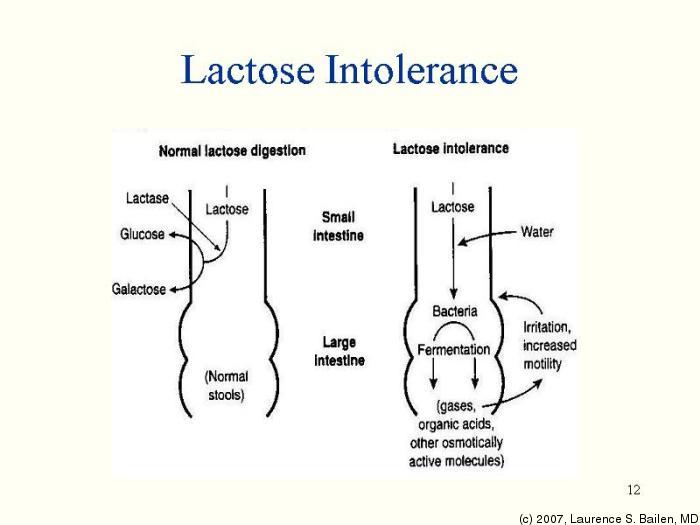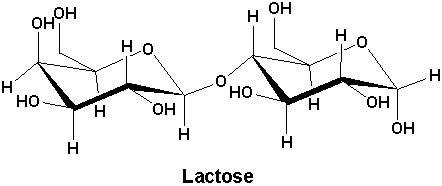 |
| Normal Lactose Digestion Compared to Lactose Intolerance |
 |
 |
| The Hydrogen Breath Test |
 |
| Symptoms of Lactose Intolerance |
In rare cases, newborns are lactose-intolerant. A person born with lactose intolerance cannot eat or drink anything with lactose. Some premature babies have temporary lactose intolerance because they are not yet able to make lactase. After a baby begins to make lactase, the condition usually goes away. Symptoms of lactose intolerance can be mild to severe. Symptoms usually begin 30 minutes to 2 hours after you eat or drink milk products. Symptoms may include bloating, pain or cramps, gurgling or rumbling sounds in your stomach, gas, loose stool or diarrhea, or throwing up. You can do a test called the hydrogen breath test where if you are lactose intolerant, you will produce more hydrogen gas. You can also take over the counter products like lactaid, which helps to digest the lactose. If you drink milk with food, that will also help. There are also diary products like yogurt and hard cheeses that a lactose intolerant person can eat without hurting them afterwards because they have smaller amounts of lactose in them. There are also alternatives to milk and diary products like soy, "dairy free products," or "lactose free" products too.
 |
| Milk is bad for you altogether |
According to the National Dairy Council there are three different types of lactates deficiencies.
1-Congenital Lactase Deficiency-This is an extremely rare condition where intestinal lactase is absent at birth
2-Secondary Lactase Deficiency-This is a condition that is the result of some disease or things such as radiation treatment. This condition is usually only temporary and a person can resume normal lactase production after they get better.
3-Primary lactase deficinecy-This is the most common type. Primary lactase deficiency is when individuals slowly lose the ability to produce lactase as they get older. Usually a person's ability to produce lactase is determined genetically.
I myself am lactose intolerant. I found out in the middle of 8th grade from my doctor. I think it was because I was consuming too much diary products because at my middle school we were only allowed to bring diary products, or it could just be that since I am a human, milk products are just not made for me. Now, I take the lactaid supplements before I eat diary products, which seem to help. I learned a lot about lactose intolerance from this research though. One thing that I was really fascinated with was with the hydrogen breath test. I would really like to do that one day just to see if I really have lactose intolerance because my doctor just said I had it when I told her my stomach hurt after I ate lunch, but my doctor never really tested me for it. Now, by doing this research, it makes me really want to stop consuming diary products all together because in one of the videos I watched, it says that milk is really only for young mammals, which we also learned in class. I also learned that I have the type three lactate deficiency, which is the most common type. It is not worth it for me and for others to consume diary products who are lactose intolerance because of the extreme pains it gives you after consuming it. I have learned just how bad diary products is to and for your body if you are lactose intolerant, that if you consume too much of it, you could possibly even die. The most important thing I have learned from this research is that when your body reacts to something you are doing to it in a negative way, you should stop what you are doing to it immediately because it is not worth it to be in pain all the time, and you also don't want to do something to your body that can question your life.
DOCTOR TRAVIS STORK SPEAKING ON SOLUTIONS FOR LACTOSE INTOLERANT PEOPLE
The Percentages of People Who Have Lactose Intolerance
African Blacks95%
American Indians90%
Asian Americans90%
North American Blacks75%
Mexican Americans75%
Mediterraneans60%
North American Whites15%
Fun Fact!
Celebrities have Lactose Intolerance too!
-Cindy Lauper-famous singer
-Mark Spitz-Olympic swimmer
Joanna Kerns-Mother on Growing Pains
Anne Hathaway-famous actress
Randy Jackson-American Idol judge and music producer
Nancy Kerrigan-Olympic ice-skater
Star Jones-host on The View
-Kimora Lee Simmons-fashion designer
-and many many more!
Check out these videos to learn more:
http://www.youtube.com/watch?v=1Pe5a4C6KmY
http://www.youtube.com/watch?v=A3iIfL8q0_k
Picture sources:
Some Symptoms of Lactose Intolerance: http://lactoseintoleranceinbabies.org/wp-content/uploads/2012/11/Lactose-Intolerance.gif
Hydrogen Breath Test: http://www.lactoseintolerant.org/wp-content/xxx.JPG
Normal Lactose Digestion & Lactose Intolerance: http://faithingeeks.files.wordpress.com/2013/04/lactose_intolerance_diagram.jpg
No More Milk: http://www.photorecipestepbystep.com/wp-content/uploads/2013/09/no-a-la-leche.jpg
Lactose: http://www.dairymoos.com/wp-content/uploads/2011/09/Lactose.gif
Video Source:
http://www.youtube.com/watch?v=kFwZYzf0OvA
Hyperlinks:
http://kidshealth.org/teen/food_fitness/nutrition/lactose_intolerance.html#
http://www.webmd.com/digestive-disorders/tc/lactose-intolerance-topic-overview
http://www.lactoseintolerant.org/
current research: http://www.collective-evolution.com/2013/04/03/over-75-of-earths-population-is-lactose-intolerant-for-a-reason-dairy-is-harmful/
http://www.dairymoos.com/what-you-need-to-know-about-lactose-intolerance-and-the-surprising-health-benefits-of-lactose/
lactase enzyme tablets
ReplyDelete